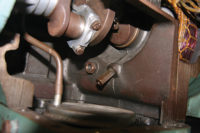Given the environmental concerns of ozone depletion and global warming, an increasing amount of thought, effort, research, and financing is being given to natural refrigerants. Natural refrigerants, such as carbon dioxide, propane, butane, isobutane, ammonia, and water — to name a few of the more popular ones — occur in nature, as opposed to synthetic refrigerants, such as chloro-fluorocarbons (CFCs), hydrochlorofluorocarbons (HCFCs), hydrofluorocarbons (HFCs), and hydrofluoroolefins (HFOs), which are man-made. Natural refrigerants have zero ozone-depletion potential (ODP) and very small, if any, global warming potential (GWP). Table 1 (above) compares the ODPs and GWPs of three natural refrigerants with two synthetic refrigerants.
A COOLING AGENT FOR CENTURIES
Water (R-718), in its liquid, vapor, and solid (ice) states, has been used as a cooling agent for thousands of years. In fact, it is one of the oldest refrigerants known. Water is an excellent refrigerant because it is environmentally safe, nontoxic, nonflammable, nonexplosive, available almost anywhere, and very inexpensive. In addition, water has a very high latent heat of vaporization (970 Btu per pound) at standard atmospheric pressure. For every pound of water vaporized, it will absorb 970 Btu of heat energy. This is a much higher value than the most commonly used synthetic refrigerants, such as R-22, R-134a, and R-404A, which have latent heat values ranging 70-90 Btu per pound when vaporized in refrigeration and air conditioning temperature ranges.
One of the disadvantages of water is its high freezing point of 32°F at atmospheric pressure. Often, water will be mixed with another fluid, such as propylene or ethylene glycol, for applications below water’s normal freezing points. Water will also be mixed with these solutions and be used as a secondary refrigerant in many chilled water and cascade refrigeration systems.
Another disadvantage occurs when water is the refrigerant in a vapor compression system. Here, the water vapor has very high specific volumes at lower temperatures, which causes high pressure ratios across the compressor and high compressor outlet temperatures. This leads to system inefficiencies and larger compressors. Because of this, special compressors must be designed and manufactured for water vapor compression applications. However, water does have a very high coefficient of performance when used in a vapor com-
pression system.
EVAPORATIVE COOLING
A very energy-efficient and effective use of water as a refrigerant occurs in the evaporative cooling process. By evaporating water, the temperature of the air in contact with the evaporating liquid water is lowered. Liquid water needs heat to phase-change (evaporate) from a liquid state to a vapor state. Thus, as each pound of liquid water is evaporated, it will absorb 970 Btu. This is an endothermic reaction, meaning heat energy is absorbed in the evaporation or phase-change process. The heat energy absorbed comes from the air in contact with the water, which will, in turn, become cooler during the process. The end product is cooler air with some water vapor entrained.
A portable evaporative cooler essentially works off this principle by acting as a cooling fan that uses water, a water pump, and a wetted surface to create the naturally occurring process of evaporation to cool warm air and drop its temperature. By pulling air across water, the temperature of the air will be lowered. A control system within a manufactured evaporative cooler operates the water pump to assist in creating this effect as a fan distributes the cool air. Evaporative coolers require about the same amount of electricity used to run standard household appliances and operate very inexpensively.
The technology at the center of an evaporative cooling system is the evaporative media surfaces that collect water. Air passes through the media and are cooled as the water evaporates. The evaporative media are treated to prevent deterioration and ensure a long service life. A water distribution system spreads water over the surface of the media within the cooling unit to ensure a uniform water supply. This keeps the entire air-to-contact surface thoroughly wet.
While evaporative coolers achieve significant temperature drops in more arid climates and dryer spaces, they will provide relief from heat in any climate. Even in regions where relative humidity reaches 70 percent at midday with temperatures above 90°, evaporative coolers have been shown to offer noteworthy relief. Given that relative humidity is lowest in the afternoon, when the temperature is at its highest, an effective evaporative cooling scenario is achievable. Evaporative coolers have been proven to deliver a temperature reduction from 8°-10° in the morning in the highest humidity regions (Miami, New Orleans, or Boston), and up to 12°-15° later in the day when the relative humidity goes down as the temperature goes up.
Although today’s portable evaporative coolers will reduce the temperature in almost any environment, for optimum performance, the temperature should be 85° or higher, and the relative humidity should be below 75 percent.
When using evaporative coolers, an increase in relative humidity of approximately 2-5 percent is often produced, depending on the temperature and humidity of the environment. However, this increase typically is not noticeable in a ventilated area where the air produced by the evaporative cooler is exhausted.
Publication date: 8/8/2016
Want more HVAC industry news and information? Join The NEWS on Facebook, Twitter, and LinkedIn today!












